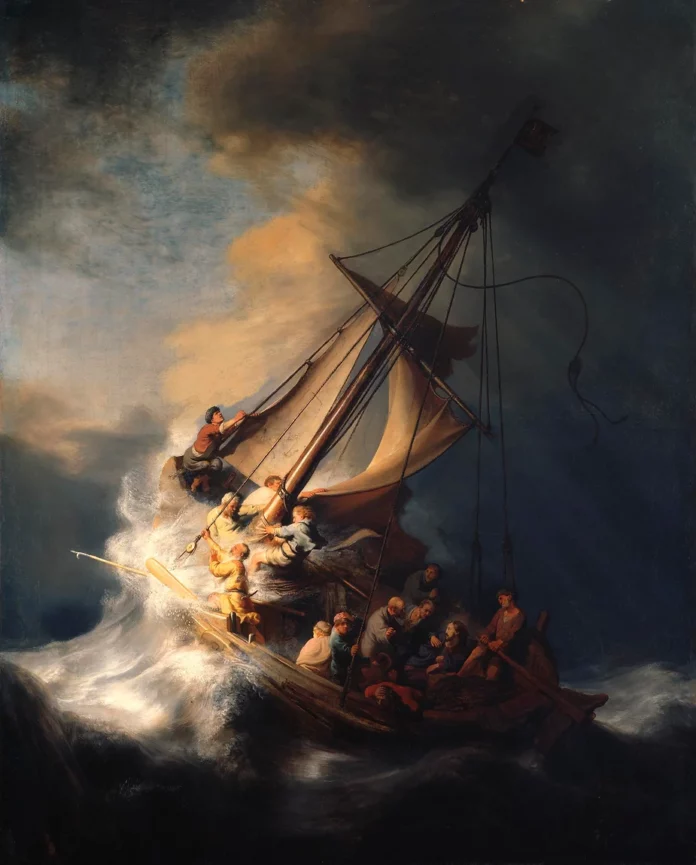“And when he had got into the boat, his disciples followed him.
And behold, a violent storm arose on the lake, so that the boat was covered by the waves; but he was asleep. And they came along and woke him up, saying: Lord, save us; we are perishing!
And he saith unto them: Why are ye fearful, O ye of little faith ? Then he arose and threatened the winds and the lake; and there was a great silence.
And the people marveled, saying, What manner of man is this, that even the winds and the lake obey him?”
Matthew 8:23-27
The fishing boat, like a nutshell, drifts on the stormy sea. The waves beat high, spray reaches the inside of the ship, the men have every effort to tighten the sails. In the left foreground, a rock comes menacingly close. On the left, the ship’s buk rises into the air. All the men react completely differently to the great danger. While many of them try to save the boat, others have awakened Jesus in the right part of the picture and plead for rescue. Jesus rises, calmed sea and wind in seconds. He is surprised, however, at the panic of his disciples, recognizing that they are questioning divine guidance.
 Christ in the storm on the Sea of Galilee, 1633
Christ in the storm on the Sea of Galilee, 1633
Contrary to the biblical source text, not 13 men have gathered on the boat, the 12 disciples and Jesus, but 14. Rembrandt, whom we find here as a so-called self-portrait “in assistenza” has scurried into the boat shortly before departure. Does he want to pretend to be the 13th disciple? At least he is the only one who makes eye contact with us and mediates between the grounds of the picture. Also, such a self-portrait “in assistenza” can be understood like a signature, a tradition that is already over 100 years old in 1633, when this work was created. The painter also holds on tightly to the rope and makes sure that the cap does not get lost.

In this situation, several moments coincide. The left part of the picture is brightly illuminated, here there is no trace of the turning to Jesus. This part is framed by three composition lines and forms a very unstable triangle. On the right, on the other hand, the part of the picture is in shadow, here the sea already seems calmer, the composition lines here form a stable triangle. The open sky on the left can be interpreted as an already heard command of Jesus, just awakened, the end of the storm is also already in sight and throws light, that is hope, on the men engaged in battle. The mast naturally bears resemblance to a cross and may indicate Jesus’ impending fate.
This work was created in Rembrandt’s 26th year, 1633, shortly after his move to Amsterdam, where he quickly made a name for himself with, among other things, the painting of the “Anatomy of Dr. Tulp”. It was to remain his only seascape of the entire ouevre. Little is known about the circumstances of the work’s creation. This biblical story is a metaphor about faith in times when the outside world threatens to collapse. The fact that Jesus can remain calm in this situation and is astonished by the panic of his disciples can only be attributed to his absolute trust in divine providence, which he also wants to grant to people. The reactions, again absolutely human, shown here nevertheless make it easy for the viewer to identify with them while being reminded that there is another source of security.




